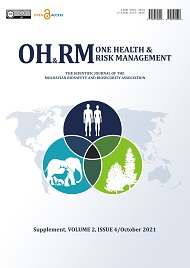Abstract
Introduction. Boron is a trace mineral that is supposed to be essential for human health. Organic boron compounds, which can be found in vegetable products are highly bioavailable for humans and can positively influence minerals such as calcium, phosphorus, magnesium and act in synergy with vitamin D, which are known to be beneficial for osteoarticular health. The aim of this study was to research the literature to determine the role of boron in preventing osteoarticular diseases.
Material and methods. This present paper analyzed 126 bibliographic sources that highlighted the boron and its compounds functions, as well as their role in preventing osteoarticular diseases.
Results. Boron is important for osteogenesis and its deficiency can lead to impaired growth and abnormal bones development. It supports bone health in postmenopausal women by reducing urinary loss of the minerals such as calcium, magnesium and phosphorus, which are essential for bone building. Boron supplementation can decrease calcitonin blood levels and increase levels of calcium and vitamin D at the same time.
According to recently published researches, people older than 40 can prevent and/or correct arthritis, osteoporosis and osteoarthritis by taking boron to or higher than 3 mg per day. In countries where soil was depleted of boron and daily intake of this mineral was 1 mg or lower, the incidence of arthritis was between 20 and 70%. Contrary to this, in countries where daily boron intake was 3 to 10 mg per day, the incidence of arthritis ranged from 0 to 10%.
A low serum level of boron was found in individuals with both rheumatoid arthritis and osteoarthritis. Low serum levels of this mineral were correlated with higher levels of rheumatoid factor, the antibody that causes destruction of the joints in both diseases. Studies that were done in the Middle East demonstrate that patients with rheumatoid arthritis have 50% lower serum boron than controls. This may suggest that boron can play a role in pathophysiology of rheumatoid arthritis and osteoarthritis and their severity.
Boron, as well as zinc, manganese, magnesium and aluminum, is present in the mineralized and non-mineralized portion of bones, although their role in bone functioning is not completely understood. Following these, one study has shown that boron levels were reduced in patients with osteoarthritis of the hip.
Calcium fructoborate, the most studied bioactive boron compounds, could be effective in reducing joint discomfort and stiffness, as well as in helping to reduce the need for use of non-steroidal anti-inflammatory drugs. It can significantly improve knee discomfort during a 2-week period when compared to placebo. Additionally, it synergizes with dexamethasone to increase the bone mineralization.
Conclusions. Boron can affect bone metabolism. An adequate intake of minimum 3 mg of boron per day is particular important for patients with rheumatoid arthritis, osteoarthritis or osteoporosis and even more important for individuals who are at high risk of developing these conditions.
|
 Views: 6932|
|
Views: 6932|
|
This work is licensed under a Creative Commons Attribution 4.0 International License.

